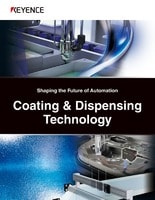Coating-Based Functionalization and Surface Processing
Functionalization/Surface Processing and Coating
There are three major purposes of coating besides adhesion in the manufacturing process.
- Functionalization
-
The process of adding new functionality to relatively thin substrates (targets) such as films, sheets, steel plates, or glass is also called "converting." In general, this is done through coating actions such as chemical agent coating, deposition, and sputtering.
Functionalization is used in a wide range of fields, such as for touch panel electrodes for smartphones and tablets, thin film coating on LCD glass, and precision pattern coating on electronic PCBs.
- Surface processing
- In addition to functionalization through deposition, surface processing is used to optimize the surface of the substrate by coating with a chemical agent. One example is the hydrophobic treatment of semiconductor wafers using a chemical agent before the resist coating process.
- Painting (design and more)
- The purpose of the painting process is not limited to cosmetic purposes. For example, in car body painting processes, multi-layer paint coats of varying paints and materials add surface protection such as chip prevention, water repellency, and heat and weather resistance.
Coating types
Coating can be divided into two major types: dry coating and wet coating.
Dry coating
Dry coating is a generic term for the technique that coats a "solid" material for functionalization of the substrate. Typical coating methods include vacuum deposition, ion plating, and sputtering. Dry coating is used for coating metal materials and allows high-quality deposition without the need of a drying process. The disadvantages are the larger size of equipment, limitations on continuous production, and higher costs.
Wet coating
The wet coating technique is commonly used in a wide range of industrial fields.
The material for functionalization is "liquefied" through the process of dissolving or dispersion into a medium. The liquefied material is uniformly applied to the substrate and then dried or cured to be converted into a solid film. When it is necessary to avoid adhesion of dust or foreign particles onto the liquid film, wet coating is performed in a clean room.
Unlike dry coating, this method does not require a vacuum environment but instead can be done in an atmospheric environment. A wide selection of equipment is available, and the target (substrate) can be fed continuously. Because wet coating provides numerous advantages in high-volume production, it has been adopted widely in various coating systems.
| Function/characteristic | Coating material |
|---|---|
| Surface functions | Hard coatings (for optical devices, automobiles, construction materials, etc.), silicone mold release agents, anti-static coatings, anti-fingerprint coatings, polyimide varnish, water/damp-proof coatings, antifog coatings (for automobiles, etc.), sound-absorbing/vibration-damping coatings, hydrophobic/oleophobic coatings, weather-resistants, photocatalytic coatings, antibacterial coatings, super hydrophilic coatings |
| Optical characteristics | High refractivity coatings, optical lens coatings, color resist/black resist, photochromic pigment coatings, optical adhesives |
| Electrical characteristics | Positive electrode material (for lithium ion batteries [LiB]), negative electrode material (for LiB), ceramic material (for LiB separators), aramid/polyamide/imide material (for insulation) |
| Others | Metal/carbon paste material, silicone coating material, fluorocarbon coating material (for medical use), cell culture substratum material |
In recent years, equipment diversification and the advancement of coating technology have broadened the scope of applications, such as precise pattern coating on the order of micrometers or nanometers, and even thinner film coating. The following table lists the application examples of thin film coating.
| Product field | Application |
|---|---|
| LCDs | Color filters, reflective films, reflection prevention films, prism sheets, LCD alignment films, inter-layer insulation coatings, transparent conductive films |
| Organic ELs | Light emitting layer, electron/hole transport layer, sealed drying |
| Semiconductors | Photoresist, passivation films, under fill, liquid encapsulation |
| Mounting/PCB/housing, etc. | FPC coating, buildup PCB inter-layer insulation films, heat dissipation coatings, electromagnetic shielding, insulation coatings |
| Information-recording media | Optical media (Blu-ray, CD, CD-R, and DVD) coating, nano imprinting, magnetic coating, sublimation printer paper |
| Optics | Optical lenses, optical fiber/optical fiber adhesion, optical component sealing, optical waveguide creation |
| Others | Containers for beverages and others (cans, bottles, PET bottles), deposition film (aluminum, silica, transparent) |






